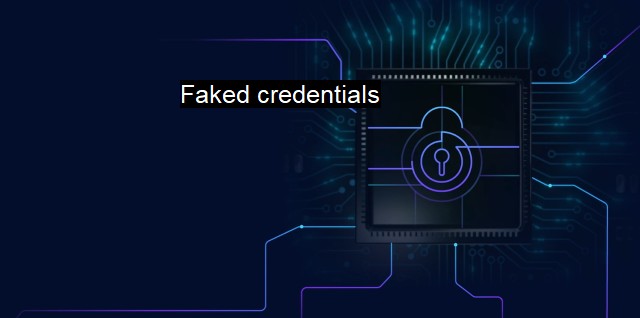What are Faked credentials?
Protecting Against Faked Credentials: The Role of Antivirus Software in Cybersecurity
Faked credentials refer to fraudulent or deceptive digital certifications meant to illegitimately gain access to systems, data, networks, or services. They represent a serious problem in a world where increasing swaths of sensitive information are stored and communicated in digital formats, requiring stringent cybersecurity measures for protection. Faked credentials pose a risk because they imitate genuine access rights, making them a favorite tool for cybercriminals attempting to commit identity theft, fraud, infringement, sabotage, or espionage. They breach security parameters, leaving personal, corporate, or government information vulnerable.Understanding the mechanisms of faked credentials begins with understanding the role of digital certificates. Typically, these are digital passports or access passes in a technologically mediated world. Credentials verify the identity of the user or device trying to gain access, adding layer protection over sensitive data. They can take varied forms such as username-password combinations, digital certificates, security tokens, hardware devices, or even biometrics.
In the case of what may be described as authentic digital credentials, lock smiths are trustworthy certificate authorities (CA). CAs issue the credentials after verifying the credentialed party's identity. The credentials can then be used to ascertain its owner's identity or proof of access rights. Still, nefarious entities continue devising mechanisms to create faked or fraudulent credentials, sidestepping these security measures.
Some common forms of faked credentials include spoofed IP addresses, cloned RFID tags, and compromised or stolen username-password combinations. Technologically advanced forms could mean counterfeit biometric scans or even collusion with rogue certificate authorities to produce seemingly valid digital certificates. Cybercriminals may obtain these faked credentials through a variety of methods, including data breaches, phishing scams, planting key loggers, breaking weak security protocols, or social engineering attacks.
Aside from illegally accessing systems or data not belonging to them, criminals also use faked credentials to mask their activities, avoiding detection or traceability. They can do exploration under the guise of a legitimate user or device, making anonymous, seemingly legit, thus less likely to raise alarms. The wide-scale damages possible from the usage of faked credentials include data theft, unauthorized transactions, installing malware, spreading viruses, information corruption, and more.
Contending against the threats of faked credentials is a significant focus of cybersecurity strategies globally. By investing in powerful antivirus software, maintaining updated firewalls or intrusion detection and prevention systems, organizations begin to fortify their digital environments from faked credentials.
These systems serve to identify irregular patterns in network usage, raise alerts on multiple failed access attempts or unusual location logins, helping detect potentially fraudulent activities. Implementing powerful and complex password structures, multi-factor authentication (MFA), biometric recognition, are critical to lower the risk of credential phishing or theft.
Segmenting networks with proper access controls or adopting the principle of least privilege (POLP) further enhances security. User behavior analytics (UBA) or user and entity behavior analytics (UEBA) enables predicting risky behavior and prevents possible security compromises. Physically securing homes and businesses by protecting computers/devices, mobile devices, accessories where digital credentials can be compromised is just as important.
Therefore, the advancement of machine learning and AI has brought a ray of hope in fighting against faked credentials. AI applications can learn patterns, pick anomalies, predict behavior, and notify irregularities even before breaching security, enhancing cybersecurity efforts multifold.
To summarize, preserving digital environments from faked credentials is a colossal challenge in the present cybersecurity landscape. A combination of proactive approaches, robust cybersecurity measures, continual vigilance, coupled with advanced technologies, will help mitigate the risk of faked credentials, thus maintaining secure cyber ecosystems. diligence is the cornerstone towards ensuring that the evolving threat of faked credentials is handled swiftly and adequately.

Faked credentials FAQs
What are faked credentials in cybersecurity?
Faked credentials in cybersecurity are fraudulent or forged documents or information that are used to falsely verify someone's identity, qualifications, or access privileges. Cybercriminals may use faked credentials to bypass security measures and gain unauthorized access to sensitive information or systems.How can faked credentials affect antivirus protection?
Faked credentials can be used to deceive antivirus software and other security protocols by granting access to otherwise restricted areas of a network or device. Once inside, cybercriminals can modify or disable antivirus programs, making it easier for them to carry out attacks without detection.What are some red flags that may indicate faked credentials?
Some red flags that may indicate faked credentials include inconsistencies in information provided, suspicious or non-existent references, or claims of expertise or experience that are difficult to verify. It's always a good idea to do a thorough background check and verify credentials before granting access or sharing sensitive information.How can I protect myself from falling victim to faked credential attacks?
To protect yourself from faked credential attacks, it's important to be vigilant and suspicious of any requests for personal or sensitive information. Implement strong access controls, including two-factor authentication, to limit exposure and require verification from trusted sources before granting access to sensitive data. It's also important to regularly update and patch your antivirus software and other security protocols to help prevent vulnerabilities that can be exploited by cybercriminals.| | A | | | B | | | C | | | D | | | E | | | F | | | G | | | H | | | I | | | J | | | K | | | L | | | M | |
| | N | | | O | | | P | | | Q | | | R | | | S | | | T | | | U | | | V | | | W | | | X | | | Y | | | Z | |
| | 1 | | | 2 | | | 3 | | | 4 | | | 7 | | | 8 | | |||||||